|
CONTENTS
Player Ejected from World Series
LSU Player in Majors
College Game
Ejected Twice in One Day
Domed Stadium
60-Homer Season
Name on Jersey; Exploding Scoreboard
World Series Game Outside U.S.
Uniforms
More Ks Than Hs
Baseball Firsts – I
Baseball Firsts – II
Baseball Firsts – III
Baseball Firsts – IV
Baseball Firsts – VI
Baseball Firsts – VII
Baseball Magazine
Golden Rankings Home
Top of Page
|
Baseball
Firsts Archive - V
Player Ejected from World Series
 Frank Chance
Frank Chance
Heinie Manush
|
The first player ejected from a World Series game was Chicago Cubs 1B and player-manager Frank Chance. He was ousted in the third inning of Game 3 of the 1910 Fall Classic against the Philadelphia Athletics at West Side Grounds in Chicago. "The Peerless Leader" argued that Danny Murphy's three-run HR into the right field bleachers should have been ruled a ground-rule double.
Chance was not the first manager ousted from the World Series. In 1907, Detroit Tigers skipper Hughie Jennings was given the heave-ho for arguing a caught stealing. Also, P Bill Donovan of the Tigers was ejected in 1908 for refusing to end his talk with the 3B coach. However, Donovan was not in the game at the time.
Some sources erroneously report that Heinie Manush of the 1933 Washington Nationals, was the first player ejected in a World Series game. Perhaps Manush's ouster gets more publicity because of what he did to earn the ump's wrath.
- In the sixth inning of Game Four at Washington's Griffith Stadium, Manush hit a grounder into the hole between SS and 3B. New York Giants SS Hughie Critz made a great stop and throw to nip Heinie at first.
- Manush started an argument with umpire Charley Moran during which he pulled the arbiter's bow tie and let it snap back.
So we can say that Manush was the first (and only) player ejected from a World Series game (or any other game?) for snapping the ump's bow tie. The future Hall-of-Famer, who led the AL with 221 hits that season as he batted .336, may have been in a bad mood because at that point he was 1-13 in the Series. The Giants won in five games, partly because they held Heinie to 2-for-18 (.111) and no RBI.
If you're wondering, Manush's given name was Henry. In that era, Heinie was a common nickname for someone named Henry.
|
|
 Al Dark
Al Dark
|
The first LSU player to make it to the major leagues was P Roland B. Howell in 1912 with the St. Louis Cardinals. Born in Napoleonville, Howell played for the Old War Skule from 1910-12. He pitched in three games for the Redbirds. In 1 2/3 innings, he gave up five hits and five runs, which is probably why he never appeared in a ML game again.
The second LSUer to play to make it to the bigs was IF Al Baird from Cleburne TX. After playing for the Tigers in 1916, he appeared in 48 games for the New York Giants in 1917 and 1919. He hit .252 in 107 ABs.
The first Bengal to forge a lengthy MLB career was SS Alvin Dark (born Comanche OK but grew up in Lake Charles) who played one glorious year of football, basketball, and baseball in Baton Rouge in 1942-3.
- Dark played for the Boston Braves from 1946-9, then for the New York Giants 1950-6. He also performed for the Cardinals (1956-8), Cubs (1958-9), Phillies (1960), and Milwaukee Braves (1960). He played in the World Series for the Braves in '48 and the Giants in '51 and '54.
- Alvin managed the San Francisco Giants from 1961-4, appearing in the World Series in his rookie year at the helm. He also skippered the Kansas City Athletics (1966-7), Cleveland Indians (1968-71), Oakland Athletics (1974-5) with whom he won the World Series in '74, and the San Diego Padres (1977).
|
|
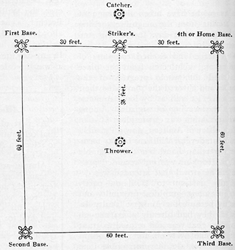
Baseball Field 1859

Action from the 2009 reenactment

1976 recreation
|
The first college baseball game in the United States took place at Pittsfield MA on July 1, 1859, when Amherst defeated Williams 73-32 in 25 innings that took 3 1/2 hours to play. Williams in a sense lost a doubleheader that weekend as Amherst also won the chess match.
Of course, the rules and customs of baseball (the "Massachusetts Rules") were much different in 1859 from what they are today.
- The lone umpire wore a bowler hat, waistcoat, and tails.
- Each side had 13 players.
- The "diamond" was a square with the batter ("striker") standing halfway between home and first.
- The pitcher was expected to feed the ball, underhanded, from 35 feet away so that the striker could hit it.
- The rectangular infield had four four-foot poles marking the bases, which were 60' apart.
- Fielders wore no gloves.
- An inning consisted of only one out, not three.
- Fielders could get an out by catching a batted ball on the fly or by hitting a runner with the ball or "soaking" him before he reached the next pole (base).
- As in cricket, there was no foul territory. So a struck ball was in play no matter which direction it went.
- A team had to score at least 65 runs to win the game.
- Each team supplied the ball that the other side had to hit. An 1859 article on the game said: "The Amherst ball weighed 2oz., and was six inches around. The Williams ball was judged to be 7 inches in circumference, and not to exceed 2 oz. It was also covered with leather of some light color, drab or buff, so as not to be easily distinguished by the batter." Amherst protested that the Williams ball was much harder to see than the white one it provided. However, as in modern protests, the matter became moot when Amherst won easily.
Starting in 1959, Williams and Amherst have recreated the original game three times.
- Williams won the centennial reenactment game 11-5 before 3,500 spectators.
- Another reenactment was conducted in 1976 in honor of the nation's centennial. Williams also prevailed in that contest, 13-12. A plaque was installed to mark the spot where the original game was played, which is not the site of the current Williams diamond.
- On May 3, 2009, the schools staged a third reenactment to mark the 150th anniversary. A team of Williams baseball alumni defeating a squad of former Amherstians 19-17 in six innings. So Williams has more than avenged the original loss, winning all three recreations.
|
Reference: "The Old Rules Apply as Williams Tops Amherst," Joshua Robinson, New York Times, May 4, 2009
|
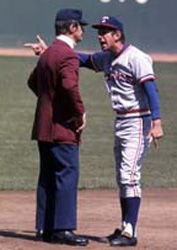
Billy Martin
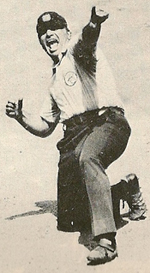
Ron Luciano
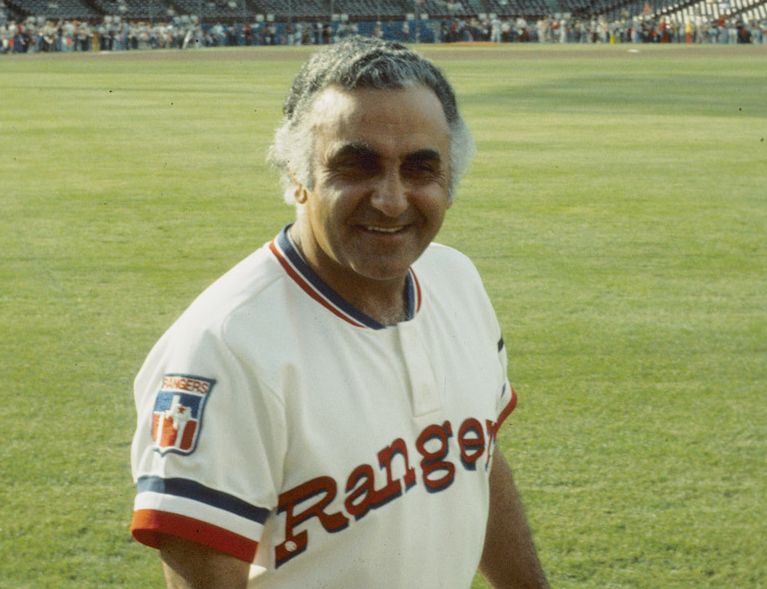
Frank Lucchesi
|
Billy Martin, as both a player and a manager, was known as an irritant to the umpires as well as the opposing team. But Billy outdid himself on Sunday, July 14, 1974, when he got ejected from both games of a doubleheader, the first time that had happened in baseball history.
Here's what occurred.
- Billy's Texas Rangers met the Milwaukee Brewers at County Stadium, Milwaukee.
- In the seventh inning of the opener, Martin was ejected by home plate umpire Ron Luciano after a pitch by Ranger reliever Pete Broberg at George Scott's head sent the batter sprawling after Scott had hit a three-run HR off Broberg in his previous at-bat. Luciano had warned both benches about brushback pitches after a delivery sailed close to the head of Robin Yount, the Brewers' SS and best hitter, in the sixth.
- Martin didn't last long in the nightcap. Art Frantz ousted him in the very first inning for protesting what Billy considered a close pitch from Jim Slaton to Ranger slugger Jeff Burroughs.
- Joining Martin in the ejection line in the DH were:
- Broberg in the eighth inning of the opener after another of his pitches came close to a batter's head.
- Texas 2B Lenny Randle in the nighcap for throwing his cap to protest being called out on a close play at 3B by Luciano.
- Texas 3B coach and acting manager Frank Lucchesi a half inning later.
- Brewer manager Del Crandall for protesting at out call at home on a attempted double steal.
- The Rangers did better in the second game when Martin left the bench in the first half-inning. After losing the opener 9-3, the visitors held on to win 5-4.
Afterwards, Martin said his first game ejection "was a shock, because Broberg can't get the ball over the plate. There is no doubt in my mind that there was nothing deliberate."
- Billy admitted that he warned Crandall and Luciano before Game One that he had ordered his starter Jackie Brown to brush back Yount.
- "I said my SS (Toby Harrah) had been knocked down four times Saturday. I told Crandall and the umpires I was going to knock down their SS, Yount – not hit him, just knock him down. I never tell a P to hit a player. That's not part of the game, but a brushback is."
A few days later, Martin was suspended for three games and fined an undisclosed amount by AL president Lee MacPhail for the remarks he made at home plate that triggered the bean ball battle between the two clubs.
Top of Page
|
The Houston Astrodome opened in 1965 as the first domed stadium in baseball.
- Called "The Eighth Wonder of the World," the Astrodome was built at a cost of $31.6 million.
- The AC bill was $30,000 per month.
- The initial capacity was 46,217, which was later enlarged to 54,816. It began the custom of entertaining fans between innings and after HRs with scoreboard spectacles, including fireworks and a snorting bull.
The first game in the Astrodome was April 9, 1965.
- The New York Yankees beat the Houston Astros (newly renamed from the Colt .45s) 2-1 in an exhibition game. Among those present was President Lyndon Johnson, a proud Texan.
- The first regular season contest was April 12. The Astros lost that one also, 2-0. Chris Short pitched a four-hitter for the Philadelphia Phillies to outduel Bob Bruce before 42,652.
Houston finished ninth in the NL, ahead of only the other expansion team, the New York Mets.
|

Astrodome
|
If I asked, "Who was the first baseball player to hit 60 HRs in a season?" you would probably answer "Babe Ruth." Right? Wrong! It was his teammate Tony Lazzeri who did it two years before the Babe's epic five dozen HR season with the Yankees in 1927. Notice that the question didn't say, "Who was the first major league player to hit 60 HRs in a season?"
- Lazzeri hit 60 HRs while playing for the Salt Lake City Bees in the Pacific Coast League in 1925.
- Tony's incredible season included 222 RBI and 202 runs. Applying the "Runs Produced" statistic of modern times (RBI + Runs – HRs), that's 364 runs produced! The most in ML history is 301 by Lou Gehrig in 1931.
- The Pacific Coast League was considered the next best circuit after the American and National Leagues.
- The New York Yankees bought Lazzeri from Salt Lake City for $75,000 after the 1925 season.
- Immediately installed at 2B to replace Joe Dugan, Tony drove in 114. Of course, his rookie season is most remembered for his strikeout with the bases loaded in the seventh inning of the seventh game of the World Series as Grover Cleveland Alexander saved the victory for the Cardinals.
- Lazzeri had over 100 RBI in six more seasons for the Bronx Bombers, incredible production from 2B.
Lazzeri retired in 1939. For some reason, he had to wait until 1991, long after his death, to be elected to the Hall of Fame by the Veterans Committee.
|

Tony Lazzeri
|
Name on Jersey; Exploding Scoreboard

Bill Veeck
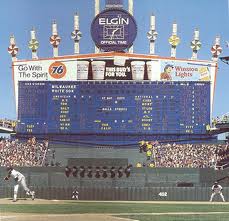
Exploding Scoreboard
|
The 1960 Chicago White Sox were the first team to wear their names of the backs of their jerseys.

The idea came from Sox owner Bill Veeck, who was well known for creative ideas to boost fan interest and attendance. That same season Veeck also installed the majors' first exploding scoreboard in CF at old Comiskey Park.
|
|
World Series Game Outside U.S.
 Cito Gaston
Cito Gaston
|
The Toronto Blue Jays, who had reached the ALCS three times previously, finally made it to the World Series in 1992 under manager Cito Gaston. Since the first Series started in the National League city that year, the third game of the 1992 World Series became the first World Series game played in Canada.
- The Blue Jays and the Atlanta Braves split the first two games.
- Tom Glavine out-dueled Jack Morris in Game One, 3-1. Each team managed only four hits.
- Ed Sprague's two-run HR in the ninth off Brave closer Jeff Reardon gave the visitors Game Two, 5-4.
- 51,813 gathered at the SkyDome on Tuesday, October 20, 1992, to watch the first Fall Classic contest ever held outside the U.S. Once again, Reardon was the victim. Entering the game as Bobby Cox's fourth P in the ninth of a 2-2 tie, Jeff gave up a bases-loaded single to Candy Maldonado that plated Robbie Alomar.
The Jays won the Series in six games to bring the first World Series championship to Canada. The triumph also made Gaston the first African-American to manage a World Series champion.
Toronto won again in 1993, also in six. Joe Carter's walkoff HR off Mitch Williams of the Phillies clinched this one in Toronto.
|
|
Uniforms
The 1849 New York Knickerbockers were the first baseball team to wear uniforms. The "uniform" consisted of straw hats, white shirts, and blue pants.
- The club had been formed in 1845 when 25-year-old Alexander Cartright codified the constitution and by-laws of the "New York Knickerbocker Base Ball Club."
- Base ball was known as "town ball" or even "The New York Game."
- Cartright's rules called for the ball to be lobbed underhanded to the batter.
- The wicket of cricket had been abandoned. Instead, the batter had to touch four bases safely to score a run. The bases were "42 paces" apart or about 90'.
- The first team to score 21 runs won the game except that both sides had to be given the same number of outs.
- Rule 13: "A player running the bases shall be out, if the ball is in the hands of an adversary on the base, as the runner is touched by it before he makes his base; it being understood, however, that in no instance is a ball to be thrown at him."
On Friday, June 19, 1846, the first recorded regular baseball game took place. The Knickerbockers defeated the New York Club 23-1 in only four innings at Elysian Fields in Hoboken NJ across the Hudson River from New York City.
|

New York Knickerbockers
Alexander Cartright top row, center.
|
More Ks Than Hs
The 2001 Milwaukee Brewers became the first team ever with more strikouts than hits.
- They had 1,399 strikouts and 1,378 hits.
- Jose Hernandez led the team with 185 whiffs.
- 1B Richie Sexson's 162 hits topped the club. However, he also had 178 whiffs.
- As you would expect, the team didn't do too well: 68-94 to finish fourth in the NL Central, 25 games behind the Houston Astros and St. Louis Cardinals, who tied for first.
- Davey Lopes presided in his second year at the helm in Milwaukee.
|
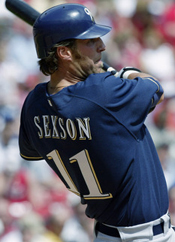 Richie Sexson
Richie Sexson
|
|